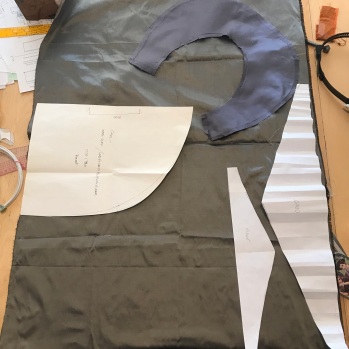Tags
beehive bonnet, bonnet, bonnets, milliner, millinery, prototyping, Research

Since 2014, I’ve been thinking about whale-bone and caned bonnets, trying the occasional prototype but not making much progress. Not too long ago, a friend and I were kicking around the idea of what the descriptions in ads and inventories actually meant. Becky’s research is always detailed and thorough, and I am grateful for all she shares with me.
We were specifically thinking about “beehive” bonnets, which also appear as “Sattin hives” and “women’s hives.” What on earth could those look like? In Philadelphia, “beehives” were described as being made of straw, which makes sense when you think of bee keeps. But wait, that’s not what the inventories and ads describe. A 1762 ad from South Carolina illustrates the distinction. (Hooper & Swallow advertisement, page 2, South-Carolina Gazette, 10 July 1762). 
Searching ads, you start see more of these, especially between 1754 and 1768. They appear from Georgia to Massachusetts, usually called “hives,” but sometimes appearing as “beehives,” or “satin hives.”

Boston Evening Post, June 30, 1755
But what did they look like? An illustration held by the Historical Society of Pennsylvania shows a woman in a poke-like bonnet of a style we might call a sunbonnet. The shape is more in line with how I imagine the “Conestoga bonnet” might look. John Fanning Watson published his Annals of Philadelphia in 1830, and while his drawings are charming and illuminating, one wonders if they are fully accurate, since Watson was born in 1779. The preponderance of “hives” seemed to be in the southern colonies, and at last, while enjoying the British Museum’s colored version of “A Society of Patriotic Ladies at Edenton in North Carolina,” I thought I had a glimpse of a “sattin hive.”
There is much to love in this print, and I have thought about it for six years since I made the first “whale-safe bonnet.” How would you make that shape? One approach might be to use techniques not unlike those used for calashes: canes in channels.
Over the past few days, I have been playing with shapes and cane, trying to get this right. After three drafts, I’m closing in, so I decided to make one up in the last of some pale grey silk to see how it behaved. Reader, the canes are annoying, and there are changes I need to make, but as Seussical as this headwear may be, I think I’m getting closer to “women’s hives.”









 For mull, I used organic cotton quilt batting. It’s a little thick, but I pull my stitches tight and don’t want the buckram or pasteboard to show too much. The old brim piece served as a pattern for new, though I did have to use a different color for the brim lining.
For mull, I used organic cotton quilt batting. It’s a little thick, but I pull my stitches tight and don’t want the buckram or pasteboard to show too much. The old brim piece served as a pattern for new, though I did have to use a different color for the brim lining.




















